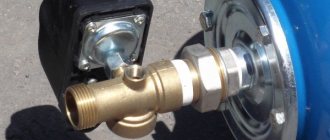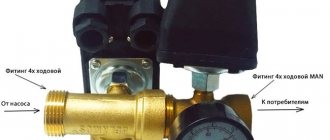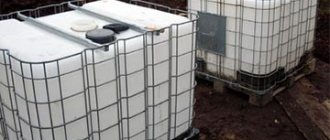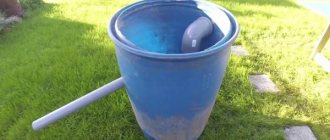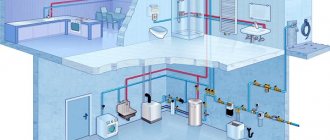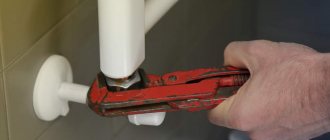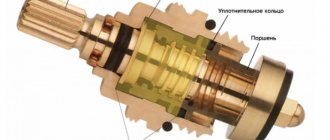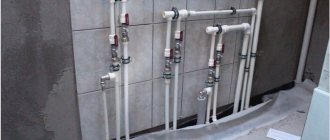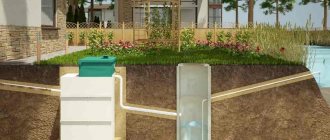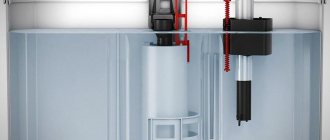When it comes to an autonomous water supply system, many owners of country houses immediately associate with two important units - a pump and a water supply accumulator.
This is due, first of all, to the fact that these structural elements play a very important role in the water supply in a private house.
It is also worth noting that a lot of information has been written about water supply pumps, but the opposite is true about hydraulic tanks. To correct this state of affairs, in this article we will describe the design of the hydraulic accumulator in as much detail as possible, talk about its functional purpose in an autonomous water supply, and also tell you what the importance of the membrane is in the design of the hydraulic tank.
- 2 Unit design
- 3 Types
3.1 Flat
- 3.2 Balloon
Advantages of using a hydraulic tank
The hydraulic tank, logically built into an autonomous water supply system, performs a number of the following important functions:
- maintains stable pressure in the water supply;
- compensates for water leaks from the water supply main;
- protects the pipeline from water hammer when turning on the pumping equipment;
- extends the life of the pump, as it limits the switching on and off of this unit.
As you can see, the hydraulic accumulator is a very important structural element of any autonomous water supply system, therefore, it is worth understanding that the functioning of the entire water supply primarily depends on its stable operation.
Design and operating features
Using a pumping station, you can solve several problems related to water supply:
- organize the automatic supply of water from the source to the water supply system of the house;
- adjust the water pressure in the water supply system, bringing it to an acceptable level;
- protect the water supply system from water hammer;
- create some water reserve in case of problems with water supply.
You can purchase a pumping station ready-made, which will make its installation a little easier, or assemble it yourself, selecting individual elements depending on your own situation.
For example, if a deep well is used as a water source, it makes sense to replace the surface pump with a suitable submersible model.
This diagram clearly shows the structure of a conventional pumping station: a hydraulic accumulator connected to a surface pump and a pressure switch
Understanding the principles of operation of a pumping station will help you understand the features of repairing this device. Its important part is the hydraulic tank - a container with a built-in rubber liner. Using a pump, water flows into the membrane part of this container. On the other side of the membrane there is air (sometimes pure nitrogen is supplied to the hydraulic tanks, but this is rare).
This combination creates a certain pressure inside the container. On one side of the tank there is a regular car nipple, through which you can bleed off excess air or pump up the missing one.
The hydraulic tank is connected to the water supply of the house. When the water is turned on, the tank is emptied and the pressure inside the container decreases. When it reaches the set value, the pump automatically turns on and water flows into the accumulator until it is full and the pressure reaches the set maximum level.
This detailed diagram allows you to understand the design and operating principle of the hydraulic tank. The air pressure in the container should be maintained at about 1.5 atm to prevent damage to the membrane (+)
Switching the pump on and off is controlled by a pressure switch. This is a small device connected to both a hydraulic accumulator and a pump. The presence of such a station has an extremely beneficial effect on both the condition of the water supply system and the operation of the pump.
The hydraulic tank serves as a buffer that protects the water supply from sudden water hammer. The pressure switch reduces the number of pump starts and stops to the required minimum, which extends the life of the equipment.
Although there is a small amount of water inside the hydraulic tank at all times, it should not be considered the main place for storing a large supply of water. The larger the volume of the hydraulic tank, the higher its price.
If you need to stock up on a significant amount of water, it is better to supplement the system with an inexpensive plastic container of a suitable volume. And a small hydraulic tank will cope quite satisfactorily with protection against water hammer.
In addition, it is important to correctly select a pumping station, focusing on the characteristics of the water source and the location of water collection points
Kinds
In the modern pumping equipment market, as a rule, two types of membranes for hydraulic tanks are offered:
- diaphragm flat;
- balloon type.
Let us dwell in more detail on the description of each type of membrane.
Flat
The diaphragm flat membrane is fixed hermetically inside the hydraulic tank housing, while dividing it into two parts:
- air;
- "wet".
The operating principle in this case is as follows:
- when the pump is turned on, water is pumped inside the unit, and the membrane begins to compress and create excess pressure in the air compartment;
- at a certain level of pressure in the accumulator, the relay turns off the pump, and the membrane directly pushes the accumulated liquid into the pipeline;
- when the minimum level is reached, the water pressure switch turns on the pump again, and the whole process is repeated cyclically.
Thus, as we see, there is a saving of both electricity and the energy resource of the pump itself.
Balloon
The balloon type of membrane is a rubber container, which in small tanks with a volume of 5 liters or more resembles a regular jar or a medical heating pad in shape, but in models with a volume of 24 liters or more it has a more pear-shaped shape.
The principle of operation of the balloon membrane consists of the following important points:
- using a pump, water is pumped inside the rubber cylinder;
- excess pressure appears between the walls of the rubber container and the body of the hydraulic tank, which, when the pump is turned off, pushes water into the main pipeline.
Thus, the balloon membrane significantly reduces the effect of water hammer on the water supply system.
You may be interested in an article on how to make a hydraulic accumulator with your own hands. Read an informative article about Gilex hydraulic accumulators here.
Operating principle of the pumping station
Knowing all the elements that create the system in question, we can consider in detail the principle of its operation. It's pretty simple:
- The station starts at the moment the tap is opened. At the same time, the pressure in the system begins to drop.
- The water that was drawn into the hydraulic compensator is returned to the system to maintain pressure. If the tap is open for a long period, the pressure drops to a point at which the relay is activated and the pump turns on.
- When the tap is closed, the pressure rises sharply. Due to this, the tank of the pumping station is filled and the relay opens the contacts.
Pumping station connection diagram
Due to this operating principle, the likelihood of intermittent operation of the system when several taps are opened simultaneously is reduced.
Causes of wear
Among the factors influencing membrane wear are the following:
- temperature changes in the accumulator;
- a constant process of compression and stretching;
- friction of the membrane against the walls of the unit housing.
The membrane naturally wears out from the above factors. As a rule, the following important points indicate signs of membrane failure:
- the hydraulic accumulator began to operate jerkily;
- the pump turns on too often at short intervals;
- the pressure gauge readings suddenly reach a high level and then rapidly fall;
- the faucet seems to “spit” water.
In situations of this kind, the obvious fact is that it is necessary to replace the hydraulic tank membrane.
Popular models of membranes for hydraulic accumulators and average prices
Let’s say right away that there are a great many different models, as well as manufacturers. Therefore, we will give a small rating of only the most popular options for this product. For the convenience of our visitors, all information below is presented in the form of a summary table.
Table. Rating of membranes for hydraulic tanks with approximate prices.
| Name, photo | Short description | Average market price, in rubles per piece |
| 1. UNIPUMP 24 liters (EPDM) | A domestically produced product, the volume of which, as you might guess from the name, is 24 liters. Made of elastic rubber (ethylene/propylene, synthetic origin). | 2200 |
| 2. UNIPUMP 5 liters (EPDM) | The characteristics in this case are almost the same, with the exception of the volume - here it is only 5 liters. | 2100 |
| 3. “Gillex” 24 liters | This hydraulic accumulator membrane is also produced in Russia and can hold up to 24 liters. | 2100 |
| 4. UNIPUMP 300 liters (EPDM) | The description and characteristics are the same as those of the first two options, only the capacity already reaches 300 liters. | 9900 |
| 5. “Gillex” 300 liters | Designed for water temperatures of no more than 99 degrees, can hold up to 300 liters of water. | 8200 |
As you can see, despite the great variety, the products of the two manufacturers mentioned above are the most popular in the country. Well, we’ve sorted out the features and other introductory points, so let’s move on to the most important thing!
How to change
To replace a worn membrane with your own hands, you must perform the following sequential steps:
- disconnect the hydraulic tank from the water supply system;
- remove air pressure in the unit through the nipple;
- drain the remaining water from the hydraulic accumulator;
- the lid with the pressure gauge is unscrewed;
- the worn membrane is pulled out through a special hole at the bottom of the body;
- the new membrane is installed in the reverse order;
- the flange with the valve is installed in place.
By following these simple steps, you will restore the hydraulic tank’s functionality with your own hands.
Thus, in this article we talked in detail about accumulator membranes, as well as the reasons for their breakdowns. We hope that by using the tips and recommendations outlined in the article, you will easily replace the hydraulic tank membrane.
Watch the video in which the user demonstrates in detail how to replace the accumulator membrane with your own hands:
Main types of membranes for hydraulic accumulators
There are several classifications; let’s look briefly at each of them. So, according to its purpose, a membrane for a hydraulic accumulator can be:
- for water supply systems;
- for heating systems.
Let's take a closer look at each of the varieties. So, membranes for hydraulic accumulators, which are used in water supply systems, have the following characteristics:
- they are made of rubber;
- designed for a pressure of no more than 7 atmospheres;
- immune to bacteria;
- can be used at temperatures ranging from 0-70 degrees.
As for products intended for heating systems, these have slightly different characteristics:
- they are made of EPDM material (special rubber, which is produced using a special technology);
- designed for a pressure of no more than 8 atmospheres;
- can be used at temperatures not exceeding 99 degrees.
The hydraulic accumulator membrane described in this article, like any other device or element, has its drawbacks. We are talking, first of all, about its instability to the following negative factors:
- sudden temperature changes;
- sudden/frequent compression;
- too high temperature (more than 70 or 90 degrees, respectively);
- too high pressure (although this point is not very relevant for water supply/heating, since the operating pressure of household pumps is low).
However, it is almost impossible to avoid negative impacts altogether. So, in the evening, water consumption increases - when we all get home, we want to cook dinner, take a shower, and so on. Because of this, the water accumulated in the tank is quickly consumed. A similar situation is observed in the morning. Therefore, despite the fact that manufacturers claim a five-year guaranteed service life of the membrane, in reality it requires more frequent replacement (we’ll talk about this in more detail at the end of the article). Ideally, its integrity should be checked at least once a year.
Note! The volume of the hydraulic tank deserves special attention, which is not surprising, because, in fact, this is a key characteristic. Modern models are produced with a volume of 8 liters or more.
For domestic use, products with capacities of 24-80 liters are most often purchased (the largest options can hold up to 2,000 liters, but for an ordinary private home this is not relevant for obvious reasons). In addition, products for 100-200 liters are quite popular (in particular, for houses where 4 or 5 people live).
